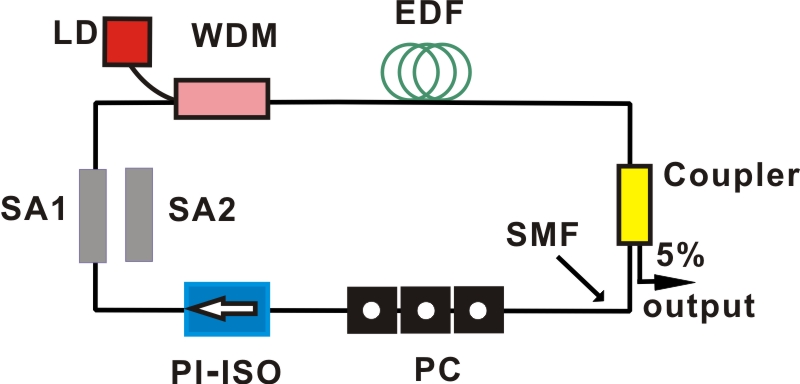Erbium-doped mode-locked fiber laser Applications
Compared with traditional solid-state lasers, fiber lasers have the advantages of small size, low cost, good stability, high beam quality, and no water cooling. Compared with other fiber lasers, NPE-based mode-locked fiber oscillators have advantages such as high pulse energy (nJ order) and narrow pulse width (on the order of hundred fs or even shorter).
Erbium-doped mode-locked fiber lasers have a wide range of applications in ultrafast optics, fiber optic sensing, industrial processing, optical information processing, frequency measurement, medical, fast ignition, etc., especially because their output wavelengths (near 1550 nm) are located at communication wavelengths. Therefore, there are extremely important applications in optical fiber communication systems, such as time-frequency transmission, large-capacity optical fiber transmission system, all-optical clock recovery, and clock division system.
Schematic

Figure 1: Schematic diagram of erbium-doped fiber laser
According to the different dispersion in the annular cavity, NPE mode-locking can be divided into: soliton-type mode-locking, widening pulse-type mode-locking, and full-positive dispersion self-similar mode-locking. Different types of lasers have different characteristics, such as: soliton is easy to achieve stable mode-locking, but single pulse energy is low; widened pulse-like pulse-mode-locked spectrum is wide, can support a shorter compression pulse width, but it needs to be in-cavity The dispersion has a certain design; the full positive dispersion has a large pulse energy from the similar class, but the pulse is wider and the noise is larger.
The intracavity dispersion of an erbium-doped fiber laser can be designed by selecting different kinds of fibers, or by adding some spatial dispersive elements (such as gratings) to adjust the intracavity dispersion.
The following is an example of a typical erbium-doped fiber-expanded pulse-type laser. The NPE erbium-doped mode-locked laser uses a half-wave plate and two quarter-wave plates to control and select the polarization in the cavity. The dispersion mode of the dispersion management class is realized by using a single mode fiber matching normal dispersion and a gain fiber length of anomalous dispersion.
- 980nm pump LD: Provides energy as a pump source for the entire oscillator, typically a single-mode pigtailed 980nm semiconductor diode. It should be noted that in actual construction, the pump module usually includes a pump laser protector to prevent 1550 nm light reflection from the oscillator into the pump source to damage the pump source.
- WDM: A wavelength division multiplexer that couples 1550 nm of signal light and 980 nm of pump light into the same fiber.
- Er gain fiber: An erbium-doped gain fiber that absorbs 980 nm of pump light and amplifies the 1550 nm signal light.
- Collimator: Collimator, which realizes the spatial collimation output of the laser in the fiber, and also facilitates the addition of some space originals (such as wave plates, polarization beam splitters, etc.) in the cavity.
- Isolator: Isolator for isolation of the reverse laser in the cavity for unidirectional, stable laser output.
- SMF: Single mode fiber with a working wavelength of 1550 nm.
Introduction to construction and operation:
Choose the right device. If a device is not suitable, it may cause low efficiency of the laser, poor pulse quality, and even a short life of the laser.
Choose a suitable working environment, including optical platform, ambient humidity, temperature, external vibration and noise, etc.
The above device is constructed and welded into a cavity according to the principle structure diagram, and the optical fiber is wound and fixed;
Turn on the pump source to a certain power level and adjust the coupling in the cavity (especially the coupling between the two collimators). If the cavity loss is too large, it is necessary to check whether there is damage to the device or solder joint damage.
After adjusting the pump source to the appropriate power, the output laser is observed using a spectrometer or oscilloscope (the latter requires the use of a photodetector to convert the optical signal into an electrical signal). Adjusting the waveplate state (two quarter-wave plates and one half-wave plate), when the stable bulge-like spectrum appears on the spectrometer and the equally stable pulses appear on the oscilloscope, the laser lock is achieved mold.
DK Photonics offers a variety of passive components for building erbium-doped mode-locked fiber laser systems, DK Photonics could provide pump combiner, optical circulator, optical isolator, tap coupler, collimator, WDM, in-line polarizer, and PBS with PM fiber or NO-PM fiber for 1.5um wavelengths. Contact DK Photonics regarding your requirements.
Click here to download the PDF file: 

